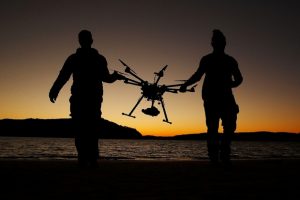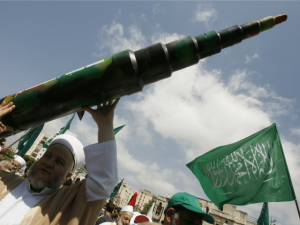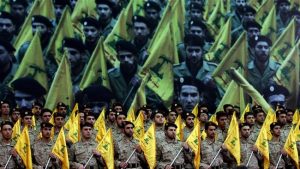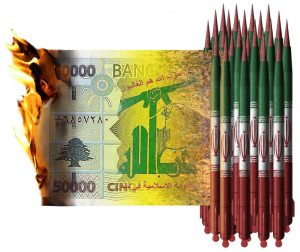Hezbollah is creating a fleet of cheap armed drones and is using them to great effect in Syria, as the group boosts a warfighting capability that analysts say could eventually be turned against Israel, like reported by middleeasteye.net.
According to video evidence, the Lebanese militant group has used small, cheap unmanned aerial vehicles, or UAVs, to drop bombs on Syrian rebels in northern Syria. A video posted on YouTube in August shows what appears to be shrapnel bombs being launched from micro-drone operated by Hezbollah.
The Times of Israel said the bombs shown in the video were Chinese-made MZD-2 sub-munitions. The MZD-2 generally contains an explosive charge, wrapped in tiny plastic or metal balls, according to the article.
The development echoes the use of UAVs by the Islamic State in Mosul, which has waged a campaign of airborne attacks on civilian areas of the east of the city, dropping grenades and IEDs from small remote controlled aircraft.
But it also shows how Hezbollah’s use of UAVs has morphed since its involvement in the Syrian war in support of the country’s president, Bashar al-Assad.
Nicholas Blanford, a Hezbollah expert at the Atlantic Council, said recent advances in technology had brought UAVs into the price range of groups such as Hezbollah.
“The technology has become cheaper and is now available for most people. A commercial off-the-shelf micro drone can be bought for as little $600,” he said.
Hezbollah’s first recorded use of drones was in 2004, when it sent an Iranian Mirsad on a brief reconnaissance mission over Israel lasting some 18 minutes before returning to Lebanon undetected.
Drones were also used by Hezbollah in 2006 in the war with Israel, said Blanford, adding that Hezbollah sent at least at three UAVs toward enemy territory. At least one carrying explosives, he said.
The launches were nonetheless unsuccessful as the UAVs were shot down by the Israeli air force or crashed before reaching the Israeli border.
By October 2012, however, Hezbollah was able to fly an advanced UAV to southern Israel, over a distance of several hundred miles, down the Israeli coast over Gaza and the Negev desert.
Analysts suspect that drone was an Iranian Shahed 129 due to the distance covered – a far more advanced military aircraft with visual similarities to American Reaper drones.
Hezbollah’s secretary-general, Hassan Nasrallah, said it was a Hezbollah mission and the group’s broadcaster, Al-Manar TV, displayed graphics indicating part of the flight path.
This drone was also shot down by Israel.
By 2014, Hezbollah launched its first successful armed drone attack when it attacked the the headquarters of the Nusra Front at Lebanon’s border with Syria, said Amine Hoteit, a retired general and Hezbollah expert.
“UAVs are used for reconnaissance, kamikaze-style strikes or targeted bombing,” said Hoteite. “The increasing weaponisation of small drones with light explosives make them an increased security challenge.”
Meanwhile, the group appears to be improving its launch capabilities to accommodate more advanced aircraft.
Initially Hezbollah launched UAVs from ramps on the back of trucks. In 2015, The UK-based Jane’s Defence Weekly revealed the existence of a 600m long, 30m wide airstrip in a remote area of Lebanon’s Bekaa valley, which it said was a UAV launch site.
Hezbollah denied there was an airstrip at that location.
Another launch site was identified in the Lebanese Bekaa Iaat area, a small village close to the century-old Baalbeck, according to local sources.
Accelerated growth
It is however the conflict in nearby Syria that has contributed to the expansion of drones used by the organisation.
During an interview last month in Lebanon, a Hezbollah fighter told Middle East Eye: “We are definitely learning a lot by working with Russians and Iranians in the Syria war and more specifically when it comes to UAVs.
“The Syria war has allowed Hezbollah to develop use of UAVs.”
Blanford meanwhile said Hezbollah was not only developing its knowledge of drones but is also practising a new set of war fighting skills in Syria.
This entails calling in strikes, improved logistics to troops deployed, improved offensive operations skills and learning to hold and control ground.
“Hezbollah moved from an entity always fighting the same enemy in the same place (Israel in south Lebanon) to multiple new war theatres, from barren mountains to flat agricultural areas and inner cities, all of which are unfamiliar to the organisation’s cadres,” he said.
“Hezbollah has also learned to fight in larger unit sizes and alongside other militaries which it has never done before. It even boasts an armoured brigade today.
“It has also learned how to use intelligence and reconnaissance to develop more complex offensive operations.”
This increased level of expertise has also reflected a change in the perception of Hezbollah by Israel. According to the Institute for National Security Studies’ annual report, it underlined a significant strengthening of Hezbollah, surpassing Iran “as the greatest danger to Israel”.
Iran was ranked the biggest threat to Israel last year.
Blanford says Hezbollah’s advances in drone technology aid the group’s “psychological war” against Israel. But their use was still in its infancy, said Hoteit.
“There is no limit to the use of drones across the Syrian border given that control of air is ensured by allies of Hezbollah, which gives a large margin of freedom to Hezbollah,” he said.
“In Israel, the air force can quickly shoot down any UAV upon detection.”
Avi Melamed, a former Israeli intelligence official and expert on Israeli affairs, said: “Israel does not underestimate Hezbollah’s military capacities.
“Israel follows closely Hezbollah in many ways and in many aspects. The use of drones is of course one of the issues closely monitored by Israel.”












